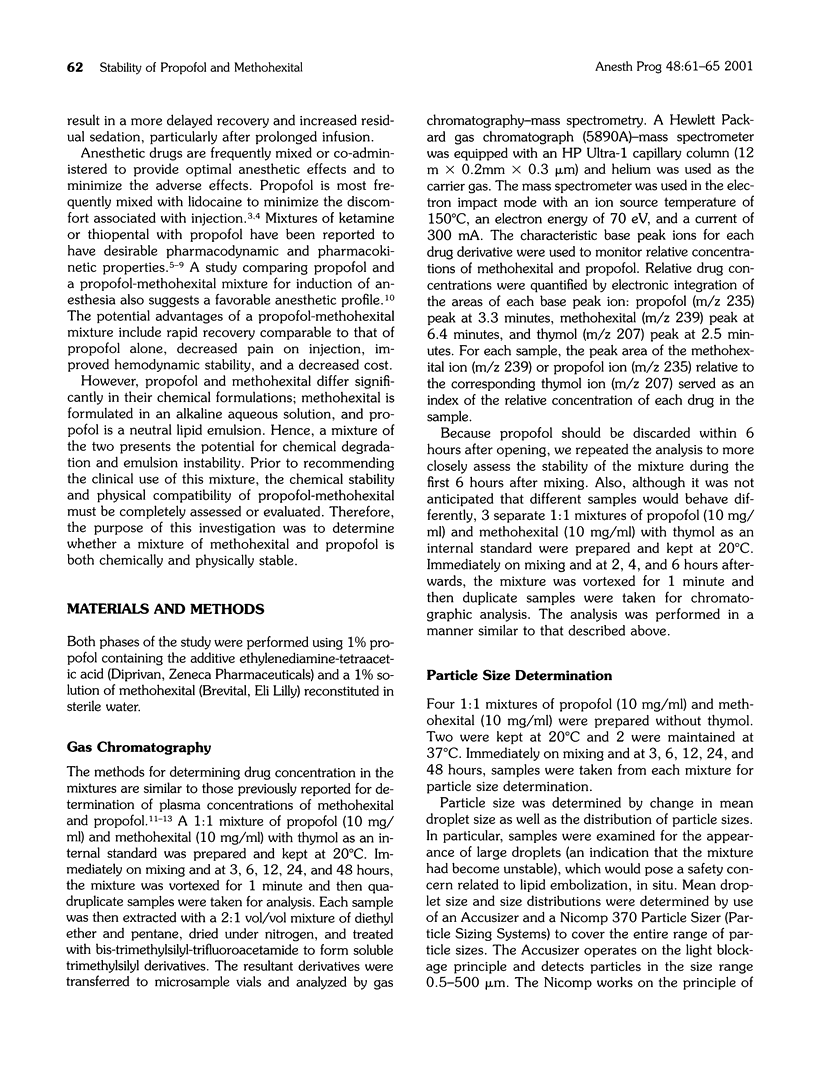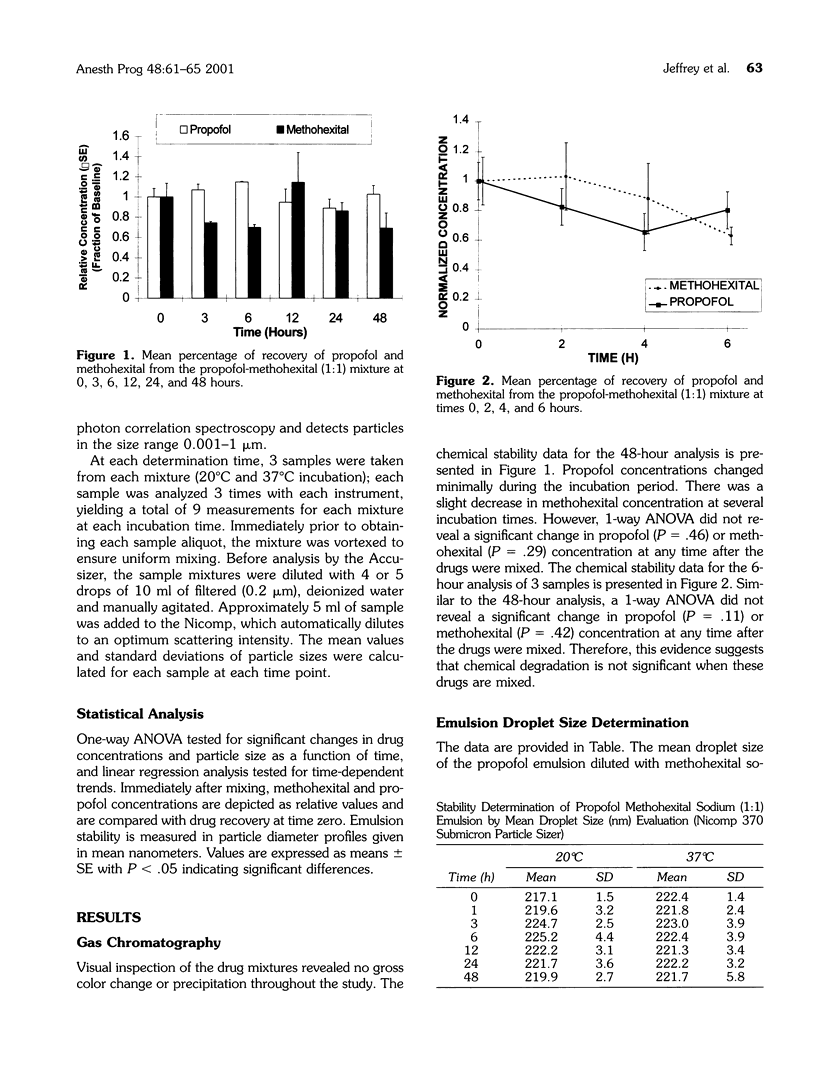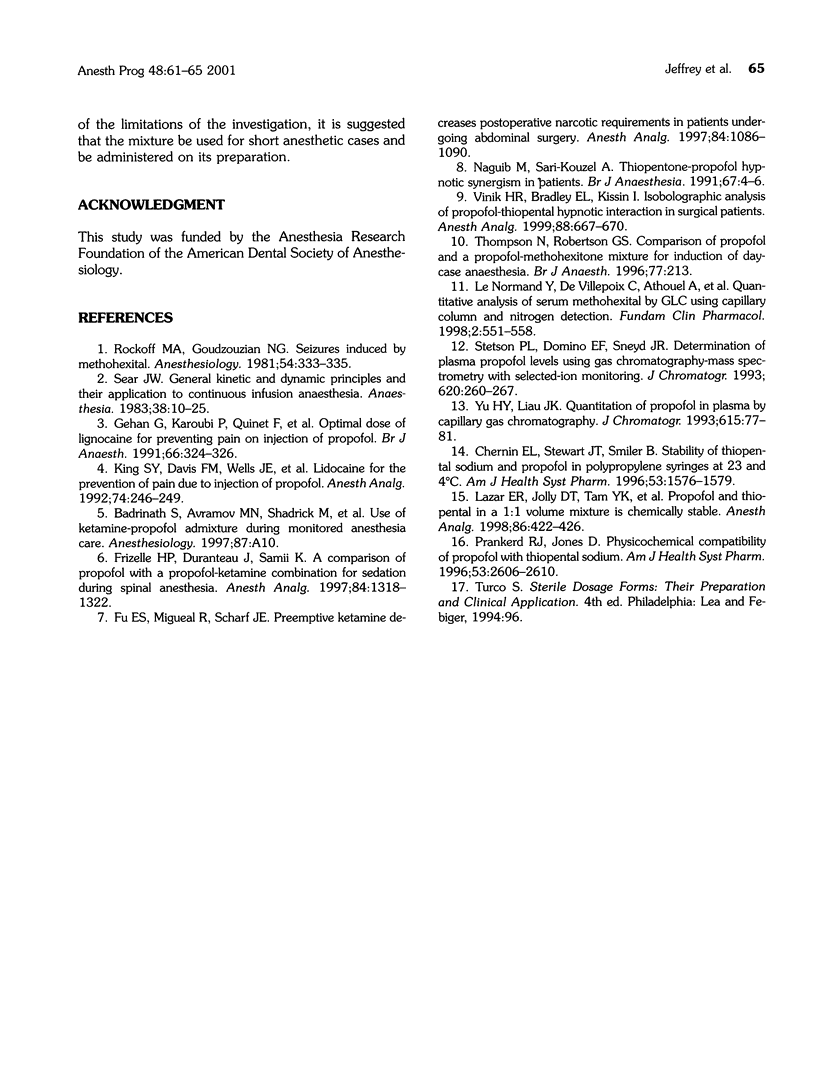Abstract
Anesthetic drugs are frequently mixed or coadministered to optimize anesthetic effects while minimizing adverse effects. Methohexital advantages include its low cost and rapid onset, while propofol provides improved airway anesthesia and extremely rapid clearance from the plasma. Therefore, a mixture of these agents might well be superior to either drug given alone. We wished to determine whether a mixture of methohexital and propofol is chemically and physically stable. A 1:1 mixture of propofol 10 mg/ml and methohexital was prepared. At times varying from 0 to 48 hours, mixtures with an internal standard of thymol kept at room temperature were thrice extracted with a 2:1 v/v mixture of diethyl ether:pentane, dried under nitrogen, and treated overnight with bis-trimethylsilyl-trifluoroacetamide. The resultant derivatives were transferred to microsample vials and analyzed by GC-MS. Drug stability was quantified by electronic integration of peak areas representing characteristic ions for each drug. For each sample, the peak area of the methohexital ion (m/z 239) or propofol ion (m/z 235) relative to the corresponding thymol ion (m/z 207) served as an index of the concentration of the drug in the sample. At times varying from 0 to 48 hours, mixtures without thymol were used to determine mean droplet size of the particles. This was accomplished using both an Accusizer and a Nicomp 370 Particle Sizer. One way ANOVA tested for significant changes in drug concentrations and mean particle size as a function of time. There was no significant breakdown of propofol or methohexital when combined in a 1:1 mixture and allowed to stand for 48 hours, nor was there an increase in particle size suggestive of emulsion instability. We concluded that a 1:1 mixture of propofol and methohexital was stable up to 48 hours after mixing.
Full text
PDF




Selected References
These references are in PubMed. This may not be the complete list of references from this article.
- Chernin E. L., Stewart J. T., Smiler B. Stability of thiopental sodium and propofol in polypropylene syringes at 23 and 4 degrees C. Am J Health Syst Pharm. 1996 Jul 1;53(13):1576–1579. doi: 10.1093/ajhp/53.13.1576. [DOI] [PubMed] [Google Scholar]
- Frizelle H. P., Duranteau J., Samii K. A comparison of propofol with a propofol-ketamine combination for sedation during spinal anesthesia. Anesth Analg. 1997 Jun;84(6):1318–1322. doi: 10.1097/00000539-199706000-00026. [DOI] [PubMed] [Google Scholar]
- Fu E. S., Miguel R., Scharf J. E. Preemptive ketamine decreases postoperative narcotic requirements in patients undergoing abdominal surgery. Anesth Analg. 1997 May;84(5):1086–1090. doi: 10.1097/00000539-199705000-00024. [DOI] [PubMed] [Google Scholar]
- Gehan G., Karoubi P., Quinet F., Leroy A., Rathat C., Pourriat J. L. Optimal dose of lignocaine for preventing pain on injection of propofol. Br J Anaesth. 1991 Mar;66(3):324–326. doi: 10.1093/bja/66.3.324. [DOI] [PubMed] [Google Scholar]
- King S. Y., Davis F. M., Wells J. E., Murchison D. J., Pryor P. J. Lidocaine for the prevention of pain due to injection of propofol. Anesth Analg. 1992 Feb;74(2):246–249. doi: 10.1213/00000539-199202000-00013. [DOI] [PubMed] [Google Scholar]
- Lazar E. R., Jolly D. T., Tam Y. K., Hrazdil J., Tawfik S. R., Clanachan A. S. Propofol and thiopental in a 1:1 volume mixture is chemically stable. Anesth Analg. 1998 Feb;86(2):422–426. doi: 10.1097/00000539-199802000-00038. [DOI] [PubMed] [Google Scholar]
- Le Normand Y., De Villepoix C., Athouel A., Kergueris M. F., Bourin M., Larousse C. Quantitative analysis of serum methohexital by GLC using capillary column and nitrogen-selective detection. Fundam Clin Pharmacol. 1988;2(6):551–558. doi: 10.1111/j.1472-8206.1988.tb00655.x. [DOI] [PubMed] [Google Scholar]
- Naguib M., Sari-Kouzel A. Thiopentone-propofol hypnotic synergism in patients. Br J Anaesth. 1991 Jul;67(1):4–6. doi: 10.1093/bja/67.1.4. [DOI] [PubMed] [Google Scholar]
- Prankerd R. J., Jones R. D. Physicochemical compatibility of propofol with thiopental sodium. Am J Health Syst Pharm. 1996 Nov 1;53(21):2606–2610. doi: 10.1093/ajhp/53.21.2606. [DOI] [PubMed] [Google Scholar]
- Rockoff M. A., Goudsouzian N. G. Seizures induced by methohexital. Anesthesiology. 1981 Apr;54(4):333–335. doi: 10.1097/00000542-198104000-00015. [DOI] [PubMed] [Google Scholar]
- Sear J. W. General kinetic and dynamic principles and their application to continuous infusion anaesthesia. Anaesthesia. 1983 Jul;38 (Suppl):10–25. doi: 10.1111/j.1365-2044.1983.tb15172.x. [DOI] [PubMed] [Google Scholar]
- Stetson P. L., Domino E. F., Sneyd J. R. Determination of plasma propofol levels using gas chromatography-mass spectrometry with selected-ion monitoring. J Chromatogr. 1993 Oct 29;620(2):260–267. doi: 10.1016/0378-4347(93)80014-u. [DOI] [PubMed] [Google Scholar]
- Thompson N., Robertson G. S. Comparison of propofol and a propofol-methohexitone mixture for induction of day-case anaesthesia. Br J Anaesth. 1996 Aug;77(2):213–216. doi: 10.1093/bja/77.2.213. [DOI] [PubMed] [Google Scholar]
- Vinik H. R., Bradley E. L., Jr, Kissin I. Isobolographic analysis of propofol-thiopental hypnotic interaction in surgical patients. Anesth Analg. 1999 Mar;88(3):667–670. doi: 10.1097/00000539-199903000-00037. [DOI] [PubMed] [Google Scholar]
- Yu H. Y., Liau J. K. Quantitation of propofol in plasma by capillary gas chromatography. J Chromatogr. 1993 May 19;615(1):77–81. doi: 10.1016/0378-4347(93)80292-c. [DOI] [PubMed] [Google Scholar]


